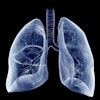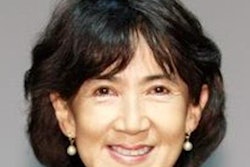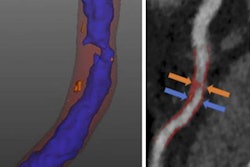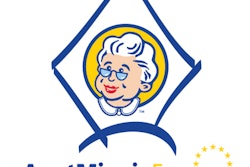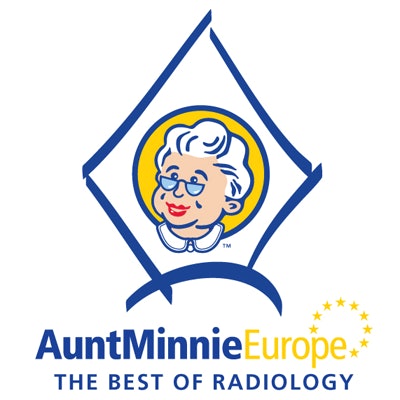
After two rounds of voting and much deliberation, the expert panel for the inaugural edition of the EuroMinnies awards has decided on the winners in eight categories. Below is a list of who the judges selected in AuntMinnieEurope.com's campaign to recognize the best and brightest in European medical imaging.
The trophy presentations will take place at ECR 2019 in Vienna, and we will be posting photos of the award winners during the congress, which begins on 27 February.
Most Influential Radiology Researcher
Dr. Vicky Goh, King's College London School of Biomedical Engineering and Imaging Sciences and Guy's & St Thomas' Hospitals, London
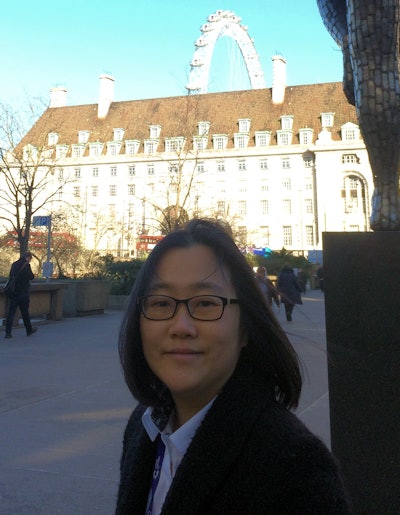 Dr. Vicky Goh from London.
Dr. Vicky Goh from London.Curiosity and a collaborative nature are the two essential qualities that researchers need to be successful in today's fast-changing and competitive environment, according to Dr. Vicky Goh. "It has not always led me down an easy path, but it has made me the researcher I am today."
She said she went into research primarily to improve her understanding of underlying disease processes in cancer, and this lies behind her focus on the tumor microenvironment.
"I wanted to make a difference to the care of patients," she said. "Cancer remains a global killer, and imaging plays such a key role in the patient pathway. The end goal of being able to contribute, even in a small way, to improve patient experience and patient outcome is what motivates me when things don't go plan."
Goh lists her main challenges as getting funding and completing the study once funded. Often, cancer patients are asked to participate in clinical studies and trials at a time when their state of mind makes them less likely to consent to participation, she noted.
"To win this award is beyond amazing," she said. "As a trainee radiologist, I remember the satisfaction I felt when my first scientific paper on pelvic floor MRI was published, but I never would have imagined that in 2019 I would be Most Influential Radiology Researcher. I hadn't even planned to have an academic career!"
She also expressed her gratitude to her colleagues and everybody she has worked with over the years.
"We would not be where we are today without their input," she pointed out. "Effective research can only come about through the efforts of many individuals."
Runner-up: Dr. Christiane Kuhl, Aachen University Hospital, Aachen, Germany
Most Effective Radiology Educator
Dr. Regina Beets-Tan, PhD, Netherlands Cancer Institute, Amsterdam
Keep your message simple, and don't assume your audience are experts in the field. That's the practical advice of Dr. Regina Beets-Tan, PhD, when it comes to giving a lecture, a tutorial, or any sort of training session.
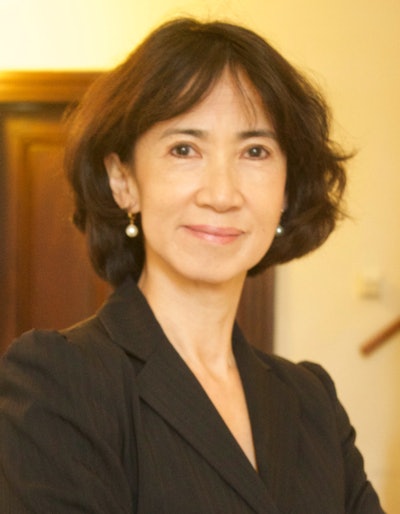 Dr. Regina Beets-Tan, PhD, from Amsterdam.
Dr. Regina Beets-Tan, PhD, from Amsterdam."Explain something as if you're explaining it to a layperson, even for radiology," she told AuntMinnieEurope.com. "Make sure you capture people's attention from the start and express your enthusiasm and passion, whatever the subject. Stick to time, prepare well, and unless you're very experienced and confident, learn your presentation by heart and stick to the script -- that's what we tell our trainees."
Although she had no real mentors herself, she said she has huge respect for Prof. Andrés Cervantes, a professor of medicine at the University of Valencia in Spain and chair of the education committee of the European Society for Medical Oncology.
"He can make a relatively dull topic like chemotherapy survival rates interesting!" noted Beets-Tan, adding that she also admires greatly the presentation skills and style of ECR 2017 President Prof. Paul Parizel, PhD, because "he always remembers he's giving a message, not just presenting evidence, and he makes his lectures so visually exciting, without trying to be too clever."
She said that she felt very honored to receive the inaugural EuroMinnies award for Most Effective Radiology Educator, and it also represents important recognition for her team. On the second day of ECR 2019 on 28 February, she will be giving the Wilhelm Conrad Röntgen Honorary Lecture about "Oncologic imaging: a new beginning has just begun."
Runner-up: Dr. Adrian Brady, Mercy University Hospital, Cork, Ireland
Radiology Rising Star
Dr. Filippo Pesapane, University of Milan, Milan, Italy
Dr. Filippo Pesapane is a resident in the final year of radiology postgraduate training at the University of Milan in Italy. He said he was inspired to specialize in radiology by Prof. Gianpaolo Carrafiello, an interventional radiologist who was his mentor in Milan. In addition to his clinical activities, Pesapane learned about research from Prof. Francesco Sardanelli, the director of radiology, who taught him the basics of evidence-based radiology.
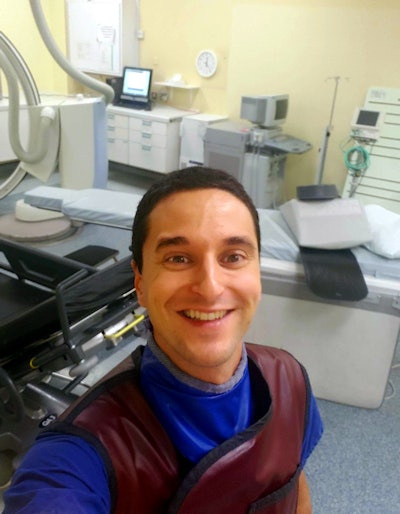 Dr. Filippo Pesapane from Milan.
Dr. Filippo Pesapane from Milan."Then I realized that to take my career to the next level, I had to leave my comfort zone and face new challenges. So I flew to Ghent in Belgium, where Prof. Geert Villeirs and his team trained me in the most innovative techniques in urogenital and breast radiology, which remain my favorite fields today," said Pesapane, noting that the group performed an original study on prostate MRI that was elected Best Scientific Communication at ECR 2018.
After a spell at the National Institutes of Health in Bethesda, Maryland, U.S., working with radiologists Drs. Brad Wood and Baris Turkbey, Pesapane returned to Italy, where he learned about state-of-the-art breast imaging from a group led by Dr. Enrico Cassano at the European Institute of Oncology (IEO).
"I believe that to build a community of radiology researchers, education fellowship programs specific to radiology residents are mandatory," he said. "The opportunity to be involved in various training schemes outside Italy has improved my ability to integrate myself, both culturally and organizationally. The more I spent time in different countries, the more I realized fear makes strangers of people who should be friends, and, in the current time of divisive nationalism, university hospitals and international societies such as ESR and RSNA have an essential role in the education of future radiologists."
Thanks to the Introduction to Research for International Young Academics (IRIYA) program, he attended a workshop at RSNA 2018 about radiology research, along with young researchers from all over the world. Also, support from the European School of Radiology enabled him to spend time at King's College Hospital in London under the supervision of Dr. Dean Huang and Prof. Paul Sidhu, before moving across London to the Royal Marsden Hospital, working with Prof. Dow-Mu Koh.
"During my training, I have tried to combine the best theoretical preparation with its practical application in clinical duties, as well as in research," he said. "This award, as winner of the Radiology Rising Star category, will inspire me to continue on this path."
In the future, he can see two major challenges facing radiology: radiomics and artificial intelligence's applications -- "fields in which the collaboration between worldwide centers will be crucial," he said. "Wherever my journey will lead, it is the journey that matters, in the end."
Runner-up: Dr. Nadya Pyatigorskaya, Pitié-Salpêtrière Hospital, Paris, France
Most Significant News Event in European Radiology
Growth of artificial intelligence and machine learning in radiology
It's safe to say that artificial intelligence (AI) has blossomed -- or perhaps even exploded -- over the past year or so. AI-based tools providing automatic quantification of measurements are a front-runner for adoption, tapping into two key themes of radiology today: efficiency of reading considering dwindling resources and the push for wider use of radiomics in diagnosis, according to industry analyst Stephen Holloway from Signify Research.

The European medical imaging community is gradually warming to the concept of AI being used for diagnoses, apparently overcoming the initial fears of AI replacing radiologists. But growing enthusiasm and anticipation of AI will only drive greater scrutiny of real-world clinical evidence and outcomes-based evidence to support use, he wrote in a recent article.
"AI for screening and high-repetition tasks also has been viewed as a promising area, with numerous start-up vendors focused on augmenting the reading of high-volume areas such as breast and lung imaging," Holloway added. "The promise of these new tools will clearly appeal to health providers and payors in the current context of radiologists' dwindling resources and a focus on limiting the cost of care provision."
The predominantly single-payor, publicly funded European market could be a tough nut to crack, such is the stringent need for long-term clinical validation ahead of more mainstream adoption, he warned.
Runner-up: Ongoing debate over safety of gadolinium MRI contrast
Scientific Paper of the Year
Coronary CT angiography and 5-year risk of myocardial infarction. The SCOT-HEART investigators, New England Journal of Medicine, September 2018.
Work on the SCOT-HEART project started back in 2009, when Prof. David Newby developed the idea and assembled the SCOT-HEART team. The work was funded by the Chief Scientist Office of the Scottish Government Health and Social Care Directorates, with supplementary awards from the British Heart Foundation, Edinburgh & Lothians Health Foundation Trust, and the Heart Diseases Research Fund.
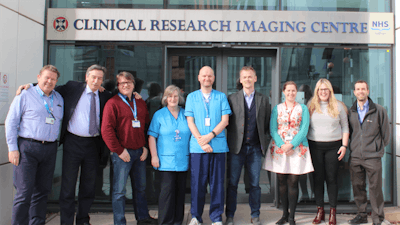 Team members from the University of Edinburgh (left to right): Edwin van Beek, David Newby, Julian Sparrow, Barbara Allen, David Brian, Scott Semple, Michelle Williams, Amanda Hunter, and Nick Weir.
Team members from the University of Edinburgh (left to right): Edwin van Beek, David Newby, Julian Sparrow, Barbara Allen, David Brian, Scott Semple, Michelle Williams, Amanda Hunter, and Nick Weir."Thanks to the hard work and dedication of the research team, which included over 100 members from around Scotland, we recruited over 4,000 patients for this study," explained Michelle Williams, PhD, a clinical research fellow at the University of Edinburgh, U.K. "We have had a fantastic response to this research, which has already led to changes in guidelines and clinical practice."
The initial two-year results were published in the Lancet in 2015 and showed that CT coronary angiography changed the diagnosis and management in 25% of patients. The five-year results published recently in the New England Journal of Medicine confirm that management based on CT coronary angiography reduced the rate of nonfatal heart attacks and coronary death.
The U.K. National Institute for Health and Care Excellence guidelines for stable chest pain have changed to include coronary CT angiography for many patients with suspected coronary artery disease, and the U.S. and European guidelines are due for revision soon, she pointed out.
"It is fantastic for our group to win this award and receive the recognition of the AuntMinnieEurope.com community. It is wonderful to be highlighted as part of the fantastic imaging research that is going on in Europe," she said. "There is a lot of work still being done on the SCOT-HEART project, and we have a number of exciting papers due to be published this year."
Recently the team published an article looking at coronary artery plaque in more detail. This study found that adverse coronary artery plaque features identified patients who were at an increased risk of nonfatal heart attacks and coronary death, but that at five years the overall burden of coronary artery disease was the most important predictor of outcomes.
"We have recently been awarded a large grant from the British Heart Foundation to conduct the SCOT-HEART 2 trial which will explore the role of CT coronary angiography for the primary prevention of coronary heart disease," Williams noted. "This will commence later this year and will recruit over 6,000 patients across Scotland."
Runner-up: One-view breast tomosynthesis versus two-view mammography in the Malmö Breast Tomosynthesis Screening Trial (MBTST): A prospective, population-based, diagnostic accuracy study. Zackrisson S et al, Lancet Oncology, November 2018.
Best New Radiology Device
Magnetom Sola 1.5-tesla MRI scanner, Siemens Healthineers
Unveiled at ECR 2018, the 1.5-tesla Magnetom Sola MRI scanner has a new magnet with higher homogeneity than the company's other 1.5-tesla scanner, Magnetom Aera. It also offers a larger field-of-view -- 50 x 50 x 50 cm -- as well as a new gradient system and coils, and comes with a number of other applications designed to speed up and automate routine exams.
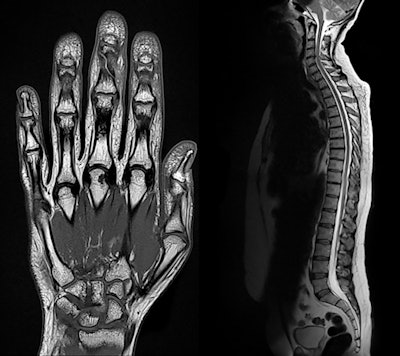 MR images acquired on the Magnetom Sola 1.5-tesla system. Images courtesy of Siemens Healthineers.
MR images acquired on the Magnetom Sola 1.5-tesla system. Images courtesy of Siemens Healthineers.The first installation of Magnetom Sola was completed at the University Medical Center Mannheim in Germany, and further European installations have come in Germany, France, Belgium, and the U.K.
"We feel honored to be among the first winners of the EuroMinnies, which recognizes excellence in European radiology," said Jan Chudzik, head of product marketing for MRI at Siemens Healthineers. "I think that Magnetom Sola is the perfect match for this premiere."
Based on BioMatrix technology, Magnetom Sola provides consistent and high-quality imaging, and it reduces unwanted variations in MRI examinations and contributes to expanding precision medicine, he added.
"By automatically adjusting to the patient's individual anatomy and physiology, we ensure highly efficient workflows, regardless of the type of examination and patient," Chudzik noted.
Runner-up: Logiq E10 ultrasound scanner, GE Healthcare
Best New Radiology Software
Mia (Mammography Intelligent Assessment), Kheiron Medical Technologies
Mia is designed to analyze standard full-field digital mammography (FFDM) exams in a breast cancer screening setting, explained Dr. Hugh Harvey, clinical director for Kheiron.
"Mia is CE-marked with the intended use as an independent (second) reader in double-reading programs by making the same high-level decision that radiologists make -- to call a woman back or not from her screening event," he stated. "In addition, Mia can triage cases for prioritization with extremely high sensitivity or act as a quality-control tool."
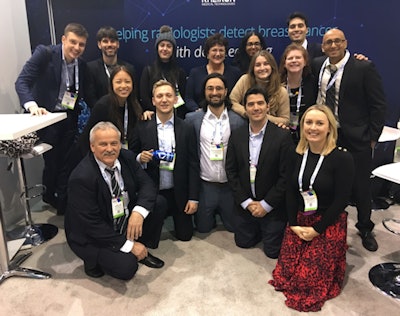 Staff at Kheiron Medical Technologies who developed the Mia (Mammography Intelligent Assessment) software.
Staff at Kheiron Medical Technologies who developed the Mia (Mammography Intelligent Assessment) software.Kheiron is working closely with the U.K National Health Service (NHS) and has been awarded government grants to support deployment in the NHS across extensive test beds and pilot sites in England and Scotland.
"We believe in robust clinical validation and will be announcing results of these projects shortly," he continued. "We have also received funding from the EU Horizon 2020 research and innovation program to scale up across Europe and are rolling out pilot sites across the EU in 2019."
The main goal is for Mia to be able to read any mammogram -- for any patient, anywhere -- while supporting the gold standard of blinded double reading in breast cancer screening everywhere possible, he emphasized. In addition, the vendor is seeking to apply its deep-learning technology to tomosynthesis cases.
Being recognized for this award means a great deal to the team, which has worked tirelessly to bring deep learning into clinical practice, noted CEO Dr. Peter Kecskemethy. Mia will be exhibited at ECR 2019 at the company's booths in the AI Expo area and booth No. 405.
"It is humbling to receive this recognition as Best New Radiology Software, especially given the fierce competition in this space," Harvey said.
Runner-up: e-CTA CT angiography analysis software, Brainomix
Best New Radiology Vendor
ScreenPoint Medical
ScreenPoint develops image analysis technology for automated reading of mammograms and digital breast tomosynthesis. It has around 25 employees, based in the Netherlands and the U.S., and their goal is to improve early detection and diagnosis of breast cancer by helping radiologists interpret mammography and breast tomosynthesis exams, using its Transpara artificial intelligence software application.
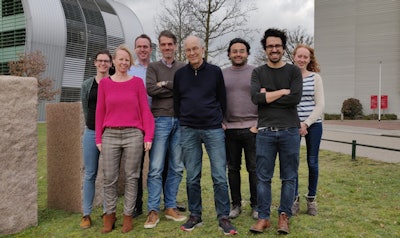 Members of the ScreenPoint Medical team in the Netherlands (left to right): Freeke Porte, Marieke de Blois, Chris Land, Pieter Kroese, Nico Karssemeijer, Umar Waqas, Albert Gubern Mérida, and Esther Smits.
Members of the ScreenPoint Medical team in the Netherlands (left to right): Freeke Porte, Marieke de Blois, Chris Land, Pieter Kroese, Nico Karssemeijer, Umar Waqas, Albert Gubern Mérida, and Esther Smits."During 2019, we will focus on accelerating our commercial growth, establishing a firm position in the international breast imaging market," CEO Prof. Nico Karssemeijer stated. "Our product development will remain focused on breast imaging, in which area our team has extensive experience and expertise."
At ECR 2019, ScreenPoint will present the latest version of Transpara, which processes 2D and 3D mammography exams and is integrated in the workstations of an increasing number of OEM partners. The company will be exhibiting in Expo X1, booth No. 120.
"We are delighted to win this award!" said Karssemeijer, who is a professor of computer-aided diagnosis in the Radboud University Faculty of Science in Nijmegen, the Netherlands. "It is really great for the team at ScreenPoint to be recognized by leading experts in radiology for their outstanding quality."
Runner-up: Kheiron Medical Technologies


